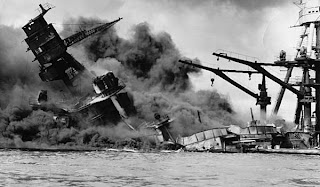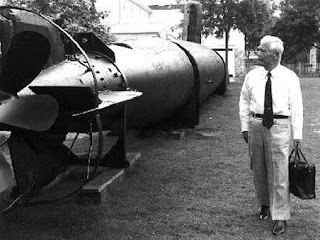December 7, 2007
Today marks the day in the history books as the day that will live in infamy. Back in December 7, 1941, war planes from a Japanese naval task force did a pre-emptied strike to the U.S. naval installation at Pearl Harbor, Hawaii. From the burning ashes of the aftermath, the sleeping giant rose to avenge those who lost their lives. I pay homage to the brave men and women who fought and died defending the freedom of mankind. Let us constantly remind ourselves that freedom and peace has a heavy price. There are times when it is necessary that human lives be laid to the altar of peace to attain its blessings.
 As an amateur historian, I have flipped and read through pages of numerous written accounts of what happened on that historical and tragic day. There are millions of interesting facts about what happened before, during and after the Pearl Harbor attack. I would like to mention just a few interesting facts about the Pearl Harbor attack.
As an amateur historian, I have flipped and read through pages of numerous written accounts of what happened on that historical and tragic day. There are millions of interesting facts about what happened before, during and after the Pearl Harbor attack. I would like to mention just a few interesting facts about the Pearl Harbor attack.Prisoner Of War #1
 One of the Japanese midget submarines that were dispatch to sneak to Pearl Harbor was manned by Ensign Kazuo Sakamaki and Petty officer second class Kiyoshi Inagaki. Their trim mechanism malfunction soon after their craft was released from their mother ship submarine. They missed the harbor entrance and crashed into a reef, damaging their midget submarine. By dawn, they crash into another reef in full view of the U.S. 298th infantry regiment that was guarding the beach off Bellow airfield. Sakamaki lit a fuse to destroy the ship before it was captured but the charge did not work. In the water, Inagaki was swept to the sea and drowned. Sakamaki was captured and became Pacific POW number 1.
One of the Japanese midget submarines that were dispatch to sneak to Pearl Harbor was manned by Ensign Kazuo Sakamaki and Petty officer second class Kiyoshi Inagaki. Their trim mechanism malfunction soon after their craft was released from their mother ship submarine. They missed the harbor entrance and crashed into a reef, damaging their midget submarine. By dawn, they crash into another reef in full view of the U.S. 298th infantry regiment that was guarding the beach off Bellow airfield. Sakamaki lit a fuse to destroy the ship before it was captured but the charge did not work. In the water, Inagaki was swept to the sea and drowned. Sakamaki was captured and became Pacific POW number 1. After the war, Sakamaki returned to Japan and became a businessman, serving as president of a Brazilian subsidiary of Toyota and then working for a Toyota-affiliated company in Japan before retiring in 1987.

His submarine was salvaged by American troops, shipped to the United States in January 1942, and taken on a nationwide tour to sell War Bonds. It was placed on display at a submarine base in Key West, Fla., in 1947 and later transferred in 1990 to its current site, the Admiral Nimitz Museum in Fredericksburg, Texas. In 1991, Mr. Sakamaki paid a visit to his old sub during a symposium on the Pearl Harbor attack.
LUCKY HIT
During the attack on Peal Harbor, a Hawaiian DC-3 airliner, coming in to land, was hit by a Japanese tracer bullet and set on fire. A minute later, the plane was hit by another bullet which hit the valve of a fire extinguisher, thus putting out the fire.
JAPANESE/AMERICANS
After the Japanese attack on Pearl Harbor, 16,849 Americans of Japanese ancestry were relocated in ten specially built War Relocation Authority Camps in the U.S. In Latin America, around 2,000 Japanese were rounded up so the US would have prisoners to exchange with Japan.
During their internment, 5,918 babies were born. A total of 2,355 internees joined the US armed forces and around 150 were killed in combat. The 100th/442nd Regimental Combat Team was formed after its members petitioned Congress for the privilege to serve in the war. It became the most decorated unit in US military history earning the following medals:
21 Medal of Honors
52 Distinguished Service Crosses (including 19 Distinguished Service Crosses which were upgraded to Medals of Honor in June 2000)
1 Distinguished service medal
560 Silver Star (plus 28 Oak Leaf Clusters for a second award)
22 Legion of merit Medals
15 Soldier’s Medals
4,000 Bronze Stars (plus 1,200 Oak Leaf Clusters for a second award; one Bronze Star was upgraded to a Medal of Honor in June 2000)
9,486 Purple Hearts
CIVILIAN CASUALTIES
One little-known aspect of the Pearl Harbor attack is that the 68 civilian casualties were killed by falling shrapnel from American antiaircraft shells.
Remember the horrors of war and the price of peace.
During the attack on Peal Harbor, a Hawaiian DC-3 airliner, coming in to land, was hit by a Japanese tracer bullet and set on fire. A minute later, the plane was hit by another bullet which hit the valve of a fire extinguisher, thus putting out the fire.
JAPANESE/AMERICANS
After the Japanese attack on Pearl Harbor, 16,849 Americans of Japanese ancestry were relocated in ten specially built War Relocation Authority Camps in the U.S. In Latin America, around 2,000 Japanese were rounded up so the US would have prisoners to exchange with Japan.
During their internment, 5,918 babies were born. A total of 2,355 internees joined the US armed forces and around 150 were killed in combat. The 100th/442nd Regimental Combat Team was formed after its members petitioned Congress for the privilege to serve in the war. It became the most decorated unit in US military history earning the following medals:
21 Medal of Honors
52 Distinguished Service Crosses (including 19 Distinguished Service Crosses which were upgraded to Medals of Honor in June 2000)
1 Distinguished service medal
560 Silver Star (plus 28 Oak Leaf Clusters for a second award)
22 Legion of merit Medals
15 Soldier’s Medals
4,000 Bronze Stars (plus 1,200 Oak Leaf Clusters for a second award; one Bronze Star was upgraded to a Medal of Honor in June 2000)
9,486 Purple Hearts
CIVILIAN CASUALTIES
One little-known aspect of the Pearl Harbor attack is that the 68 civilian casualties were killed by falling shrapnel from American antiaircraft shells.
Remember the horrors of war and the price of peace.
No comments:
Post a Comment